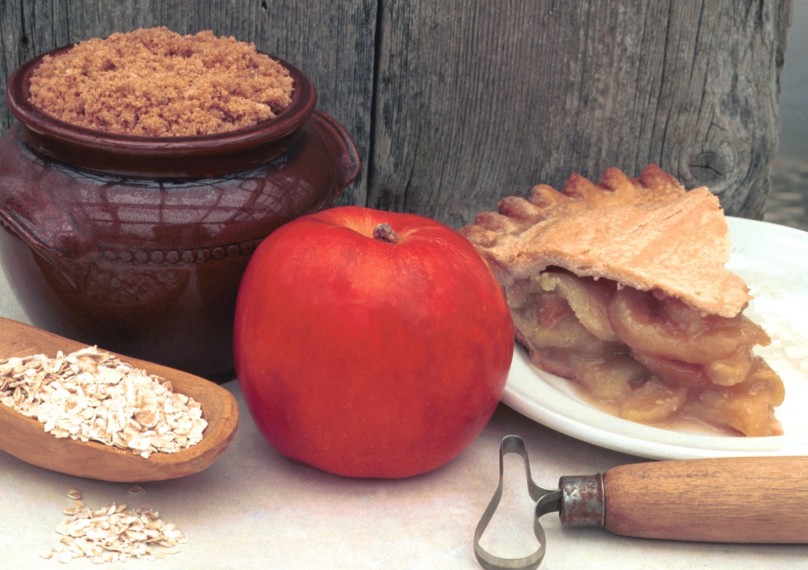

GRAVENSTEIN
| Origin | Unknown. Possibly from North Germany or South Tyrrol. Grown in Denmark in 1669. |
| Parentage | Unknown. |
| Availability | Early September to October. Good for cooking from late August. With the best modern storage it will retain quality into January. |
| Source | Widely available from commercial nurseries. |
| Quality | Distinctive. At its best, Gravenstein is still one of the best eating apples and a preferred cooking apple in Nova Scotia. Flesh is firm, crisp and juicy. |
| Fruit: |
| Size | Normally large but may be variable depending on crop load. |
| Surface | Glossy, slightly ridged. |
| Ground Colour | Light green to light yellow, depending on maturity and ripeness. |
| Over Colour | Variable. From the light blush-stripe of the 'old fashioned' or yellow Gravenstein to the full glossy crimson red of the best Crimson Gravenstein strains. Time of harvest and, to a lesser extent, the season will affect the amount and intensity of the over colour. Blotchiness (i.e., unevenness in the red over colour) is typical of many, though not all, Crimson Gravenstein strains. |
| Flesh Colour | Creamy white. |
| Pressure | 17.5 to 18.5 lbs. |
| Harvest Season | Around early September depending on the season. Time is fairly critical for best quality but may vary from late August or early September for 'cooker' grade to late September depending on target market niche. Spot picking at least once is necessary for recovery of maximum quality crop. Harvest can be started in late August by tree application of a natural ripening growth regulator (ethylene). |
| Storage | Unfortunately, extended storage of Gravenstein has never been too worthwhile, in part because Gravenstein tends to lose its peak distinctive aromatic-acid-sugar balance in both cold and Controlled Atmosphere (CA)storage. Recently however, low oxygen CA storage has shown promise in retaining this harvest-time quality. Cold storage is, of course, indicated for all Gravensteins in order to retain crispness until marketed. |
| Strains | There are three types: the original 'old fashioned' or yellow Gravenstein, the Banks Red and the Crimson, or red, type. The highly blushed Banks Red was discovered near Berwick, Nova Scotia in about 1880 and was the source in turn of a full red Crimson sport. Probably only Crimson strains, of which there are many, and a few yellow Gravenstein trees exist today, the Banks having disappeared. Recommended strains: Washington has been the most widely grown but is a blotchy type. Only virus-free scion wood of any strain should be used for propagation. |
| Tree: |
| Vigour | Large, vigourous when young. As the tree ages vigour declines and limbs become somewhat spurry. |
| Habit | Upright spreading to roundish open. Branch angles are usually fairly wide, although lateral shoots of young trees may turn upright and require spreading or tying down. |
| Precocity | Fairly precocious for a triploid. Gravensteins tend toward light cropping until early vigour has slowed and a good spur system has developed. |
| Fruit Placement | Primarily spur bearing, often sets several fruits per cluster; on young trees may even blossom on last season's shoots. |
| Bloom Period | Early to very early. |
| Pollination | Pollinated by all early blooming diploid cultivars. As a triploid, Gravenstein does not pollinize other cultivars. |
| Nutrition | Normal orchard practice to provide balance between growth and cropping. Somewhat subject to bitter-pit so Calcium supply may need to be supplimented with foliar sprays, especially when extended storage is planned. |
| Crop | Moderately heavy cropper. Becomes biennial. Aggressive blossom thinning is required even in light years. Hand thinning of clusters is desirable. |
| Synchrony | Requires spot picking. Tends to have considerable pre-harvest drop, in part due to early maturing of insect injuries or of moldy cored fruits. Also in part due to intra-cluster pushing as the fruit grows rapidly near harvest. |
| Adaptation | In Maritime cool summer climates it is not considered cold hardy. |
| Disease Reaction | Fairly resistant to scab. Somewhat subject to powdery mildew and European canker. Subject to flat limb virus (and occasionally to limb sun scald) which may then be followed by canker. Subject to bitter pit and moldy core. |
| Insect Reaction | Very subject to rosy aphids. Somewhat susceptible to apple maggot and codling moth. |
| Rootstock | The more dwarfing stocks develop a large overgrowth just below the union. A wide range of size-controlling rootstocks have been used with MM106 and MM111 the most widely planted. Older orchards on 'French crab' seedlings did well. Beautiful Arcade seedlings sometimes are slow to promote full cropping. Virus clean dwarf rootstocks and strains may perform more typically. |
| Comments: |
| Uniquely adapted to cool summer, mild winter climates (eg. Norway, part of California, Nova Scotia, etc.), Gravenstein has remained a favourite in those regions but not well known elsewhere. As with most cultivars, Gravenstein has its own characteristics. These are covered above and appropriate remedies suggested to get the best from this outstanding apple. |
|
|
Back |

|
Next |
|